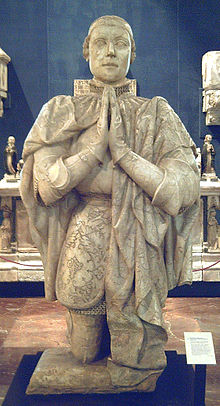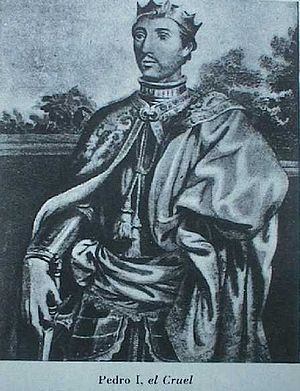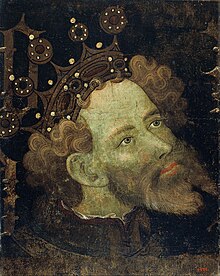War of the two Peter
| date | 1356-1375 |
|---|---|
| place | Castile, Aragon, Mediterranean |
| output | draw |
| consequences | Uncertain |
| Peace treaty | Peace of Almazán |
The War of the Two Peter ( Spanish La Guerra de los Dos Pedros ; Catalan Guerra dels dos Peres ) was fought between the kingdoms of Castile and Aragon between 1356 and 1375 . He was named because of the identical first names of the kings of both countries, Peter I of Castile and Peter IV of Aragon .
background

In the second half of the 14th century, Castile suffered from unrest caused by the civil war that was fought for the throne between local and allied troops of the ruling king, Peter of Castile and his half-brother Henry of Trastámara .
Heinrich was supported by the French commander-in-chief Bertrand du Guesclin and his "free companies", as well as by Peter IV of Aragon. Peter of Castile, on the other hand, was supported by the English . The war of the two Peter is therefore related to the Hundred Years War in France, just like the First Castilian Civil War .
Peter I of Castile planned to incorporate the Kingdom of Valencia into his kingdom, which also included parts of Murcia , Elche , Alicante , and Orihuela . Peter IV of Aragon, on the other hand, intended to rule the western Mediterranean at the expense of Castile and at the expense of Castile's ally, the Republic of Genoa . For this he wanted to bring the kingdom of Murcia under his control, which would have separated Castile from the Mediterranean and Genoa and made his goal possible.
A maritime event had already caused tensions between the two powers: Catalan galleys , which were equipped by Mossèn Francesc de Perellós and had received the letters of piracy from the Aragonese king, helped France against England and had also made it, at Sanlúcar de Barrameda in front of Peter I., who happened to be there to hijack two Genoese ships. It was a humiliation for Peter I, and besides, Genoa was an ally of Castile. That is why Peter of Castile personally pursued the Catalan galleys with the help of the Castilian fleet. He caught up with Francesc de Perellós in Tavira , but he was unable to capture him. After all, this was the event that sparked the war.
war
The war lasted from 1356 to 1375; it was extended because Heinrich von Trastamara overthrew Peter I. The war was mainly fought between Castile and Aragon, especially in the border towns of Aragon such as Tarazona and Teruel , which fell into the hands of the Castilians.
1356-1363
In 1357, Castile invaded Aragón and captured Tarazona on March 9th. On May 8, however, they agreed on a temporary armistice. In the middle of the year 1358 Castile broke this armistice and tried to conquer Barcelona by sea in order to win the war in this way. But the expedition failed in front of the city, despite successes in the Mediterranean. However, she also made Castile aware of the importance of its own fleet. But one also recognized the inevitability of a land offensive in order to defeat Aragon.
At the beginning of 1361 the Castilians conquered the fortresses of Verdejo , Torrijos , Alhama and other places. However, the Peace of Terrer (sometimes also called Peace of Deza ) was agreed on May 18, 1361, in which all conquered areas and castles were returned to their former masters. Bernardo de Cabrera, ambassador of the Aragonese king, ensured peace. Peter IV married his daughter Constance to Friedrich III. of Sicily .
In June 1362 Peter of Castile met with Charles II of Navarre in Soria to promise mutual help. Peter also formed an alliance with Edward III. of England and his son, the Black Prince .
After these negotiations were over, the Castilian king attacked the Kingdom of Aragon again without declaring war, and the conflict broke out again. The Aragonese king was in Perpignan without troops and was completely surprised. The Castilians took the castles of Ariza , Ateca , Terrer , Moros , Cetina and Alhama . But it was impossible for Peter of Castile to take Calatayud , although he attacked it with all kinds of siege equipment. Without continuing with the conquests, he returned to Seville .
During this time, Peter IV of Aragon received support from Heinrich von Trastámara, who had wanted to overthrow Peter I since 1351 and had tried to do so earlier in the First Castilian Civil War . He launched attacks on Castile, but had no long-term success worth mentioning and lost several of his brothers during these battles.
In 1363, Castile continued to wage war against Aragon and again conquered Tarazona. Peter of Castile received reinforcements from Portugal and Navarre . In the meantime, the King of Aragon signed a treaty with France and a secret treaty with Henry II of Castile. Peter of Castile then conquered Cariñena , Teruel , Segorbe , Sagunt , Almenara, Xiva and Buñol .
The papal nuncio Jean de la Grange arranged the Treaty of Sagunto of July 2, 1363 between the two kings. The treaty was not signed, however, and the fighting continued. The Castilians invaded the Kingdom of Valencia in 1363 and conquered u. a. Alicante , Caudete , Elda and Gandia .
1363-1369
From 1365 to 1369 Peter of Castile was focused on protecting his position in Castile against his half-brother Henry II of Trastámara. Through his French allies he was able to recruit mercenaries from 1365, including Bertrand du Guesclin and Hugh Calveley for his project.
The first Castilian civil war began to escalate in 1366 when Henry II, now armed with a very large army, marched in from France and overthrew Peter of Castile from his throne. Peter then left the country unopposed; He fled to Portugal, where he was received coolly by his uncle Peter I of Portugal , and then to Galicia , in northern Spain, where he ordered the murders of Suero, the Archbishop of Santiago , and the Dean Perálvarez.
Eventually he found refuge in Bayonne with the English. He formed an alliance with them to regain the throne and came back with an army in 1367. With English troops he defeated Henry II in the battle of Nájera and thus regained the throne, while Henry II had to flee again to France.
However, Heinrich II did not give up and attacked again in 1369. In the Treaty of Toledo (1368) he had ensured the full support of the French, to whom he promised in return the future aid of the Castilian fleet against the English. In the battles that followed, Peter I was personally killed by his own half-brother Heinrich II during the decisive Battle of Montiel , which led to his final accession to the throne.
Invasion of Valencia
The emirate of Granada supported Peter of Castile during the war. Castilian troops and their Moorish allies attacked the south of Valencia , which suffered destruction and political instability.
The Castilians successfully attacked the Kingdom of Valencia in 1364; Peter I of Castile was almost able to conquer the city of Valencia, but very bad weather hampered the Castilian fleet at sea and ensured that the siege of Valencia, both on land and at sea, was impossible and the project had to fail in the end.
End of war
The war finally ended in 1375 with the Peace of Almazán . There were no winners because neither side could gain terrain. Castile got back several areas that were still under Aragonese control, including Molina , and vice versa. In order to ensure the success of the peace, a marriage between Eleanor of Aragon, the daughter of Peter IV of Aragon, and John I of Castile , the son and successor of Henry II of Castile, was arranged.
This war was a tragedy for the Kingdom of Aragon as it was where most of the fighting took place. In addition to the destruction and devastation that the war had caused on land and at sea, these were also intensified by the occurrence of the plague and other catastrophes such as droughts and a migratory locust plague. These events also ruined the Aragonese economy and resulted in a decline in the population. Tarazona Cathedral, which was destroyed during the war, was not rebuilt for a long time.
However, the war also set in motion administrative and military developments that eventually led to the unification of the kingdoms of Castile and Aragon during the time of the Catholic Monarchs in the next century .
literature
- José Manuel Calderón Ortega, Francisco Javier Díaz González: Los almirantes del "siglo de oro" from the Marina castellana medieval . In: Universidad Complutense de Madrid, Departamento de Historia Medieval (ed.): En la España medieval . tape January 24 , 2001, ISSN 0214-3038 , p. 311–364 (Spanish, online at Revistas Científicas Complutenses [PDF; 4.4 MB ; accessed on September 28, 2019]).
- Clara Estow: Pedro the Cruel of Castile, 1350-1369 (= The Medieval Mediterranean: Peoples, Economies and Cultures . No. 6 ). EJ Brill, Leiden, New York 1995, ISBN 90-04-10094-6 (English).
- Juan Antonio Martínez Gómez-Gordo: Doña Blanca de Borbón . la prisionera del castillo de Sigüenza: su historia y su leyenda (= Tierra de Guadalajara . No. 18 ). Aache Ediciones, Guadalajara 1998, ISBN 84-87743-96-X (Spanish).
- Cesáreo Fernández Duro: La marina de Castilla . desde su origen y pugna con la de Inglaterra hasta la refundición en la Armada española. Ed .: Real academia de la historia (= Historia general de España ). El. Progreso Editorial, Madrid 1894 (Spanish, online on Internet Archive [accessed September 28, 2019]).
Web links
- Sergio Martínez Gil: La Guerra de los Dos Pedros (1356-1367). In: Historia de Aragón, historiaragon.com. May 14, 2016, Retrieved September 28, 2019 (Spanish).
- Mario Lafuente Gómez: La guerra de los Dos Pedros en Aragón (1356-1366) . Impacto y trascendencia de un conflicto bajomedieval. Tesis Doctoral Tomo I Universidad de Zaragoza. Ed .: Universidad de Zaragoza, Departamento de Historia Medieval. Zaragoza 2009 ( unizar.es [PDF; 14.0 MB ]).

